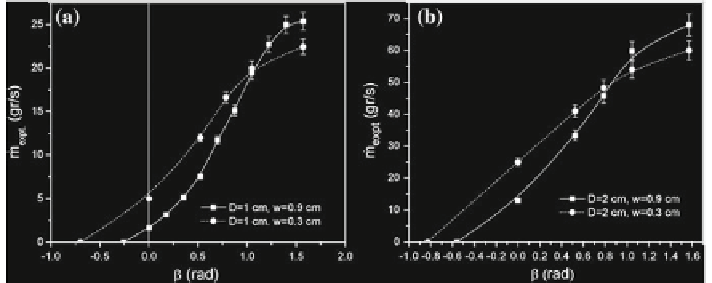Environmental Engineering Reference
In-Depth Information
Fig. 14
Plot of the measured mass flow rates in tilted bins,
m
ʲ
expt
, as a function of the tilt angle,
ʲ
=
, through circular orifices. In
a
we use sand and orifices of diameter
D
1 cm and face walls
of thicknesses
w
=
.
3cmand
w
=
.
9 cm to notice the effect of
w
.In
b
granulated sugar were
employed and in this case we used holes of diameter
D
0
0
=
2 cm. Lines connecting the data were
draw for visual facility, error bars are of 4%
the bin is tilted up to the desired angle
with the vertical (measured clockwise),
the granular jet emerging perpendicular to the face wall is gather into a reservoir
fixed to a digital force sensor. Details of the measurement procedure of the discharge
rates with a force sensor model Pasco CI-6537 are given elsewhere (Medina et al.
2014
). In the current experiments we found that the wall friction coefficient among
granulated sugar and acrylic was
ʲ
μ
w
=
.
±
0
70
0.01, while among sand beach and
μ
w
=
.
±
acrylic it was
0.01.
At a first stage, the mass flow rates for a given angle
0
80
ʲ
were measured for face
walls having wall thicknesses with values
w
3 and 0.9 cm. For each face wall
several circular orifices were drilled. In Fig.
14
we show the experimental values of
m
ʲ
expt
, as a function of
=
0
.
, for both materials which show a sine-like behavior. It
is important to comment that the flows of sand and sugar were arrested at different
critical inclination angles,
ʲ
ʲ
∗
, for sand:
ʲ
∗
=−
0
.
26 rad if
D
=
1 cmand
w
=
0
.
9cm,
ʲ
∗
=−
ʲ
∗
=−
while
0
.
76 rad if
D
=
1 cm and
w
=
0
.
3 cm. For sugar
0
.
57 rad if
ʲ
∗
=−
3 cm. Another
important physical fact in this figure is that for the same orifice size but large tilt
angles
D
=
2 cm and
w
=
0
.
9 cm and
0
.
83 if
D
=
2 cm and
w
=
0
.
ʲ
the flow rate is stronger in the orifices of larger thickness!
4.4 The Formulation of a Correlation
The search of a general correlation that embraces the dependence of the flow rate
m
ʲ
deserves a careful analysis. At a first glance it is easy to con-
clude that if the vertical wall is considerably thick, there will be no efflux of granular
material through the orifices. Thus, the influence of the wall thickness,
w
,mustbe
present wherever the granular flow occurs. Here we introduce a correlation that is
on
D
,
w
and
ʲ

Search WWH ::

Custom Search